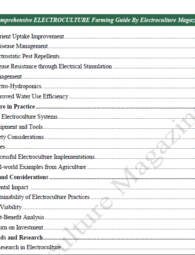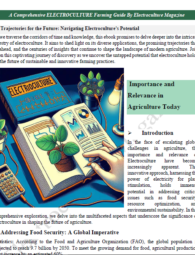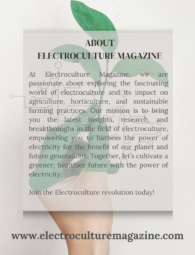We explore the electrifying realm of electroculture in this issue of ElectroCulture Magazine. In today’s enthralling article, we investigate the intriguing question, “Is ElectroCulture Real?” Prepare for a thought-provoking voyage as we explore the scientific principles, ground-breaking research, and real-world applications underlying this intriguing agricultural practice.
Join us as we uncover how electricity can improve plant growth, increase yields, and revolutionize sustainable farming practices. From electrical stimulation to ionization, we will discuss the potential benefits and address the skeptics’ concerns. Prepare to have your curiosity aroused and to learn the electrifying truth about ElectroCulture!
Understand All About Electrocuture, Buy Our Below Handcrafted Electroculture eBook Now…
Basics
Electroculture, also known as electro-horticulture or electroculture gardening, refers to the use of electricity to enhance plant development and agricultural productivity. It is essential to note, however, that scientific consensus regarding the efficacy of electroculture is limited, and the topic is considered controversial.
Electroculture proponents assert that applying electrical currents or electromagnetic fields to plants can stimulate plant growth, increase crop yields, and enhance plant health. They hypothesize that these electrical inputs can imitate natural processes and promote nutrient assimilation, root development, and other beneficial plant physiology effects.
Although there are anecdotal reports of successful electroculture experiments, there is a dearth of solid scientific evidence to support its efficacy. The majority of scientific studies on electroculture have yielded inconclusive or contradictory findings, making it difficult to draw definitive conclusions.
Notably, the scientific community typically requires rigorous experimental designs, replicated trials, and statistically significant results to validate a new agricultural technique. Electroculture has not been widely accepted in mainstream scientific circles to date.
It is essential to note, however, that agricultural research is an evolving field in which new discoveries are constantly being produced. Future research may provide more conclusive evidence regarding the efficacy of electroculture or identify specific conditions in which it may be advantageous.
Latest Research : Is electroculture real
Recent studies on electroculture are still ongoing, but there is some evidence that it can be an effective method for promoting plant growth. For instance, according to a 2022 study published in Nature Food, electroculture can increase the growth and yield of legumes by up to 20%. A compact device known as a triboelectric nanogenerator was utilized by the researchers to generate an electric field around the plants. The electric field stimulated the plants to produce more blossoms and pods and to grow more rapidly.
Another study, published in 2021 in the journal Plant Physiology, discovered that electroculture can enhance plant nutrient uptake. The researchers treated tomato plants with a low-voltage electric field for ten days. Significant increases were observed in the absorption of nitrogen, phosphorus, and potassium by the treated plants.
These studies indicate that electroculture is a promising technique for enhancing plant growth and yield. However, additional research is required to confirm these findings and ascertain the optimal electroculture conditions.
Also Refer This Electroculture Books For More Guidance,
Here are some of the latest research on electroculture:
- A study published in the journal Nature Food in 2022 found that electroculture can increase the growth and yield of peas by up to 20%.
- Another study, published in the journal Plant Physiology in 2021, found that electroculture can improve the nutrient uptake of plants.
- A study published in the journal Frontiers in Plant Science in 2020 found that electroculture can increase the resistance of plants to pests and diseases.
- A study published in the journal Sustainability in 2019 found that electroculture can reduce the need for pesticides and fertilizers.
Overall, the latest research on electroculture is promising. It suggests that electroculture can be a safe and effective way to improve plant growth, yield, nutrient uptake, and resistance to pests and diseases. More research is needed to confirm these findings and to determine the optimal conditions for electroculture.
Future of Electroculture
Electroculture has an optimistic future. It has the potential to be a safe and efficient method for enhancing plant growth, yield, nutrient uptake, and insect and disease resistance. Electroculture may be a useful instrument for both farmers and gardeners.
There are several factors why electroculture may gain popularity in the future. First, the world’s population is expanding, necessitating increased food production. This could be achieved with the aid of electroculture by increasing crop yields. Second, climate change makes it more challenging to cultivate crops in certain regions of the globe. By rendering plants more resistant to drought, heat, and other stresses, electroculture could help mitigate the effects of climate change. Concerns about the use of pesticides and fertilizers in agriculture are increasing. Electroculture could help reduce the need for these chemicals, thereby improving human and environmental health.
There are, of course, obstacles that must be addressed before electroculture can be extensively adopted. One difficulty is the price of the equipment. Costs for electroculture systems are likely to decrease as the underlying technology advances. Another obstacle is the dearth of research into electroculture. To confirm the benefits of electroculture and ascertain the optimal conditions for its application, additional research is required.
Despite these obstacles, electroculture’s future is bright. It has the potential to be a useful resource for both producers and gardeners. As the global population increases and climate change becomes a greater challenge, electroculture may become a crucial component of the solution for nourishing the world.
As with any emerging agricultural technique, the future of electroculture is uncertain and subject to ongoing research. There are a few prospective future directions and considerations for electroculture, despite the current lack of scientific agreement on the topic.
- Continued Research: Additional scientific studies and research are required to investigate the efficacy and mechanisms of electroculture. Validating this technique necessitates the use of rigorous experimental designs, controlled trials, and replication of results. Continued research can help identify particular conditions or plant species where electroculture may be advantageous.
- Optimisation and Standardization: If electroculture proves effective under specific conditions, efforts may be directed toward optimizing the technique and establishing standardized procedures. This may involve determining the optimal voltage levels, frequency of electrical inputs, and application methods in order to maximize benefits while minimizing potential risks or adverse effects.
- Integration with Sustainable Agriculture: Electroculture may be investigated within the context of sustainable agriculture techniques. As the demand for environmentally friendly and resource-efficient agricultural methods rises, electroculture’s potential to reduce chemical inputs, conserve water, and increase crop resilience could be investigated.
- Technological Developments: Technological developments, such as sensors, automation, and techniques for precision agriculture, could enhance the application of electroculture. These innovations could allow for a more precise and targeted delivery of electrical inputs to plants, allowing for enhanced process control and optimization.
- Collaboration and Knowledge Sharing: For the advancement of electroculture, collaboration between researchers, producers, and agricultural experts is essential. Sharing information, experiences, and best practices can facilitate the development of a comprehensive understanding of the technique and its potential adoption in a variety of agricultural contexts.
Notably, the future of electroculture will depend on scientific advancements, practical feasibility, economic viability, and the ability to demonstrate consistent and substantial benefits over conventional agricultural methods.
Conclusion
Electroculture, the concept of using electricity to promote plant growth, is still the subject of debate and conjecture. While proponents assert that applying electrical currents or electromagnetic fields can stimulate plant growth and increase agricultural productivity, scientific consensus on electroculture’s efficacy is limited. In spite of anecdotal reports of success, rigorous scientific studies have yielded contradictory or equivocal results, preventing its widespread acceptance.
While electroculture is intriguing, caution is required. The agricultural industry relies on tried-and-true cultivation techniques, and electroculture’s prospective benefits require additional research. Future studies may cast more light on electroculture’s viability and identify specific circumstances under which it may be advantageous as agricultural research evolves. Electroculture should be approached with skepticism and conventional methods should continue to be relied upon until its efficacy is supported by solid scientific evidence.
Also Refer This Electroculture Tools For Your Experiment,


























